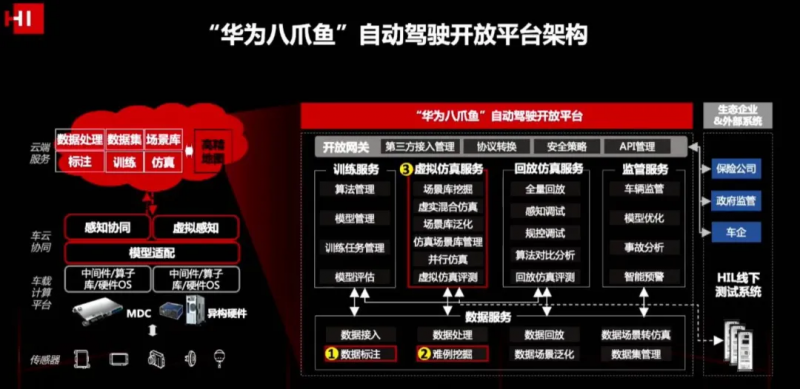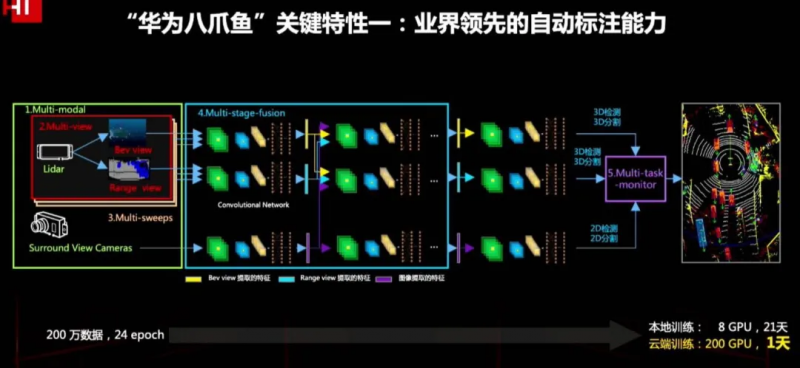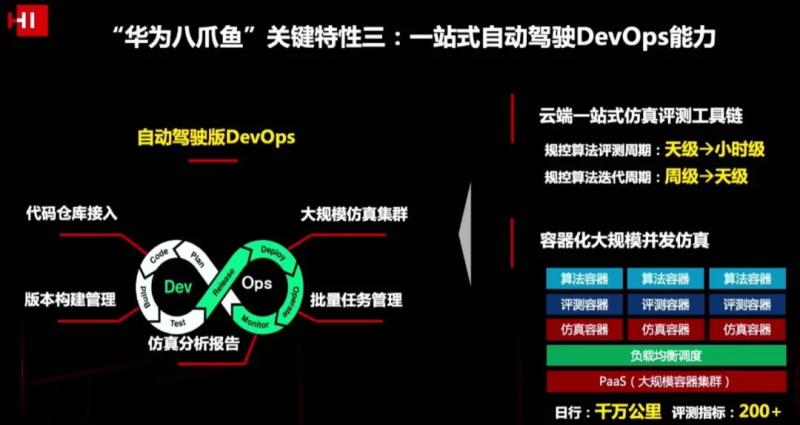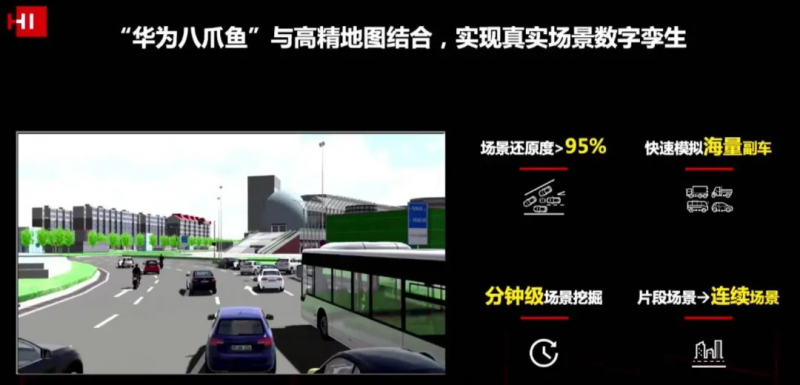"Huawei Octopus" refers to Huawei's autonomous driving cloud service HUAWEI Octopus, which is based on the core hardware of autonomous driving: data, high-precision maps, and algorithms. It builds a data-driven closed-loop open platform, which aims to assist automakers in building autonomous driving development capabilities from scratch and lower the development threshold through vehicle-cloud collaborative capability encapsulation, labeling capabilities, upgraded virtual simulation, and safe and compliant one-stop cloud services. Together with the intelligent driving computing platform MDC and intelligent driving OS, it leverages the advantages of Huawei Cloud + AI to form the vehicle-cloud collaborative MDC intelligent driving platform, open up cooperation, and promote the rapid development of intelligent driving.
Why is Huawei's autonomous driving cloud service named "Huawei Octopus"? As we know, the octopus is known as the primate in the ocean. It has a smart brain, strong learning ability, and a high degree of evolution. This is very similar to the core capabilities required for the development and implementation of autonomous driving today: autonomous driving perception requires continuous learning in order to be ubiquitous.
Compared with OTT cloud services and traditional tools, Huawei leverages its years of accumulation in ICT technologies such as cloud computing, Internet of Vehicles, and artificial intelligence to build a unified, full-stack cloud platform for the entire life cycle of autonomous driving.
Huawei Octopus' three major services
"Octopus" is an on-demand full-stack cloud platform that covers the entire life cycle of autonomous driving data, models, training, simulation, labeling, etc. It provides three major services including data services, training services, and simulation services to car companies and developers.
Data services: Process sensor data output on the vehicle hardware platform, and replay data in different formats such as radar and camera; support PB-level massive storage, interactive big data query and massive data governance.
Training service: Manage and train autonomous driving models, continuously improve the accuracy of models on new data sets and test sets, and continuously improve the safety factor of autonomous driving. The platform provides software and hardware acceleration, which can significantly shorten training time and improve training efficiency.
Simulation service: Provides application tools such as simulation, scenario library management, scenario clips, and evaluation systems to ensure that autonomous driving models are compliant, safe, measurable, and meet quality standards, and can be quickly integrated into the version.
Six key features of Huawei Octopus:
1. Industry-leading automatic annotation capabilities
The "Huawei Octopus" autonomous driving open platform team and Huawei Noah Laboratory have formed a joint team and continued to tackle key issues. The accuracy of the perception algorithm has reached the industry-leading level, solving industry problems such as missed detection and false detection in complex scenarios or remote targets, and has achieved leading positions in multiple international public dataset test challenges for autonomous driving.
Taking 3D point cloud target detection as an example, Huawei integrates various information extracted by different sensors such as lidar and cameras, and extracts target features by fusing multi-view and multi-time series data. Through multi-layer convolution network iteration, different features are integrated to finally achieve accurate recognition and detection of 3D point cloud targets. Combined with the powerful computing power of the cloud, the training efficiency of this super-large model can be increased by more than 10 times, thereby improving the iteration speed of the vehicle-side perception model.
2. Intelligent screening of difficult scenarios with cloud and MDC collaboration
Through the collaboration between the cloud and the vehicle-mounted computing platform MDC, it is possible to achieve intelligent screening of difficult scenarios, solve the performance bottleneck of intelligent analysis and detection algorithms, collect vehicle-side and cloud-side data in a targeted manner, discover difficult cases (Corner cases) in the data, and greatly alleviate the long tail problem.
Developers upload the difficult-example images they want to collect to the cloud, and the cloud will send the difficult-example collection rules to the vehicle. The vehicle will detect the real-time data stream captured by the camera, find similar difficult-example scenes, capture the corresponding images and send them back to the cloud to form a difficult-example dataset for a specific scene. This method can reduce 90% of the data uploaded to the cloud and save 70% of the dataset construction time.
3. One-stop autonomous driving DevOps service
The "Huawei Octopus" autonomous driving open platform provides a one-stop simulation and evaluation tool chain in the cloud, realizing DevOps in the field of autonomous driving, and realizing a complete automated closed loop from code repository access and version management to simulation and evaluation.
Through large-scale concurrent simulation, the iteration speed of the regulatory control algorithm can be increased by an order of magnitude, and the virtual simulation test mileage can reach tens of millions of kilometers per day. This efficient model shortens the regulatory control algorithm evaluation cycle from days to hours, and the iteration cycle of the entire algorithm from weeks to days.
4. Combined with high-precision maps, it can realize real-scene digital twins and virtual-reality hybrid simulation
The most time-consuming part of the iterative development of regulatory control algorithms is test verification. On the one hand, autonomous vehicles require astronomical mileage tests for verification, and on the other hand, the construction of test scenarios has become the biggest difficulty in this link.
Virtual simulation is an effective means to improve the efficiency of autonomous driving verification, but it has very high requirements for the diversity of the scene library and the realism of virtual simulation. The "Huawei Octopus" autonomous driving open platform can convert the collected typical road sections into simulation scenes, and combine them with high-precision maps to realize the digital twin of real scenes. This method can achieve more than 95% scene restoration capabilities, which can effectively help developers quickly simulate surrounding vehicles, realize minute-level scene construction, and effectively verify complex urban traffic scenes, supporting SIL (software in the loop) verification.
The virtual-reality hybrid simulation of "Huawei Octopus" realizes online and offline collaboration by combining real vehicles and virtual scenes. By building test scenes in the cloud and then loading the simulated test scenes onto the vehicle side for operation, it can simulate various required virtual scenes and dangerous scenes on open roads or sites, such as following vehicles, pedestrians crossing, non-motor vehicle CUT-IN, avoiding static obstacles, etc., to test and verify the autonomous driving algorithm, the vehicle dynamics performance of the real vehicle, and the driving experience.
Greatly accelerated the efficiency and quality of VIL testing.
5. Pre-set massive data sets and scene libraries
The Huawei Octopus autonomous driving open platform can provide more than 50 categories, more than 1.2 million images, and more than 20 million objects with labeled data sets. And these data will be iterated monthly and gradually grow. Combined with efficient labeling tools and intelligent pre-labeling algorithms, it can help autonomous driving developers build complete data collection, processing, automatic labeling, difficult example mining, and generation of incremental data sets, etc., to quickly iterate perception algorithms.
In addition, the "Huawei Octopus" autonomous driving open platform has built a library of more than 200,000 simulation scenarios, supports the generalization of scenario libraries, and can help autonomous driving developers quickly build highly restored simulation scenarios through real-scene digital twins and virtual-reality hybrid simulations, greatly improving the efficiency of simulation testing.
6. Cloud-pipe-device-chip collaboration, seamless connection between car and cloud
HUAWEI Octopus naturally supports seamless connection with vehicle-side hardware platforms such as MDC (Mobile Data Center) and ADAS systems to achieve vehicle-cloud collaboration.
It is said that Huawei will integrate high-precision maps, 5G and V2X technologies, more AI algorithms, simulation scenarios and other capabilities into "Huawei Octopus" in the future, and work with more car companies and developers to accelerate the rapid commercialization of intelligent driving and jointly move towards a new era of intelligent connected vehicles.
Previous article:China has a promising future in the field of autonomous driving, and Continental will increase its investment in China
Next article:Continental AG announces partnership with Horizon Robotics to establish smart driving joint venture
- Popular Resources
- Popular amplifiers
- Car key in the left hand, liveness detection radar in the right hand, UWB is imperative for cars!
- After a decade of rapid development, domestic CIS has entered the market
- Aegis Dagger Battery + Thor EM-i Super Hybrid, Geely New Energy has thrown out two "king bombs"
- A brief discussion on functional safety - fault, error, and failure
- In the smart car 2.0 cycle, these core industry chains are facing major opportunities!
- The United States and Japan are developing new batteries. CATL faces challenges? How should China's new energy battery industry respond?
- Murata launches high-precision 6-axis inertial sensor for automobiles
- Ford patents pre-charge alarm to help save costs and respond to emergencies
- New real-time microcontroller system from Texas Instruments enables smarter processing in automotive and industrial applications
- LED chemical incompatibility test to see which chemicals LEDs can be used with
- Application of ARM9 hardware coprocessor on WinCE embedded motherboard
- What are the key points for selecting rotor flowmeter?
- LM317 high power charger circuit
- A brief analysis of Embest's application and development of embedded medical devices
- Single-phase RC protection circuit
- stm32 PVD programmable voltage monitor
- Introduction and measurement of edge trigger and level trigger of 51 single chip microcomputer
- Improved design of Linux system software shell protection technology
- What to do if the ABB robot protection device stops
- Allegro MicroSystems Introduces Advanced Magnetic and Inductive Position Sensing Solutions at Electronica 2024
- Car key in the left hand, liveness detection radar in the right hand, UWB is imperative for cars!
- After a decade of rapid development, domestic CIS has entered the market
- Aegis Dagger Battery + Thor EM-i Super Hybrid, Geely New Energy has thrown out two "king bombs"
- A brief discussion on functional safety - fault, error, and failure
- In the smart car 2.0 cycle, these core industry chains are facing major opportunities!
- The United States and Japan are developing new batteries. CATL faces challenges? How should China's new energy battery industry respond?
- Murata launches high-precision 6-axis inertial sensor for automobiles
- Ford patents pre-charge alarm to help save costs and respond to emergencies
- New real-time microcontroller system from Texas Instruments enables smarter processing in automotive and industrial applications
- Live broadcast at 10 am today [Renesas Electronics Secure IoT Suite provides you with secure cloud connection solutions
- Applications of RF Transformers
- RF FilterRF knowledge classics to understand
- 【NXP Rapid IoT Review】+Hello world!
- 5G miniaturized terminal and base station antenna technology
- DIY retro game console based on Raspberry Pi Zero
- Transistor static operating point
- The History of DSP and Why No One Mentions DSP Anymore
- RISC-V MCU IDE MRS (MounRiver Studio) development: Add standard math library reference
- A brief introduction to the timer A function of the 430 microcontroller







 AM310H
AM310H











 京公网安备 11010802033920号
京公网安备 11010802033920号